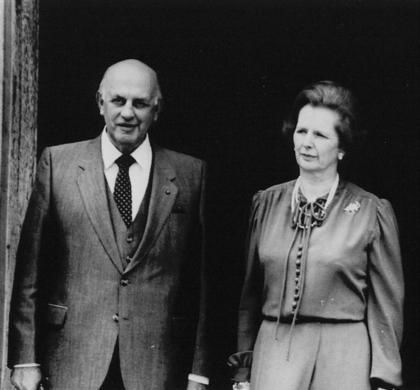Difference between revisions of "Margaret Thatcher"
(From Chequers to Lockerbie) |
(Adding image, expanding and referencing) |
||
| Line 1: | Line 1: | ||
| − | '''Margaret Hilda Thatcher''' (born 13 October 1925, died 8 April 2013) was Prime Minister of the United Kingdom from 1979 to 1990 and leader of the Conservative Party from 1975 to 1990. A Soviet journalist called her "The Iron Lady", a nickname which became associated with her uncompromising politics and leadership style. As Prime Minister, she implemented Conservative policies that have come to be known as Thatcherism. Margaret Thatcher (née Roberts) held a life peerage as Baroness Thatcher of Kesteven in the County of Lincolnshire, which entitled her to sit in the House of Lords. | + | [[File:Thatcher's_themed_funeral.jpg|600px|right|thumb|Cartoonist Steve Bell on the "Falklands War theme" funeral of [[Margaret Thatcher]] ]] |
| + | '''Margaret Hilda Thatcher''' (born 13 October 1925, died 8 April 2013) was Prime Minister of the United Kingdom from 1979 to 1990 and leader of the Conservative Party from 1975 to 1990. A Soviet journalist called her "[[The Iron Lady]]", a nickname which became associated with her uncompromising politics and leadership style. As Prime Minister, she implemented Conservative policies that have come to be known as Thatcherism. Margaret Thatcher (née Roberts) held a life peerage as Baroness Thatcher of Kesteven in the County of Lincolnshire, which entitled her to sit in the House of Lords. | ||
| − | On 8 April 2013, a Buckingham Palace spokesman said: "The Queen was sad to hear the news of the death of Baroness Thatcher. Her Majesty will be sending a private message of sympathy to the family."<ref>[http://www.bbc.co.uk/news/uk-politics-22067155 "Ex-Prime Minister Baroness Thatcher dies, aged 87"]</ref> | + | On 8 April 2013, a Buckingham Palace spokesman said: "The Queen was sad to hear the news of the death of Baroness Thatcher. Her Majesty will be sending a private message of sympathy to the family."<ref>[http://www.bbc.co.uk/news/uk-politics-22067155 "Ex-Prime Minister Baroness Thatcher dies, aged 87"]</ref> However, Baroness Thatcher was mourned by few in South Africa: "I say good riddance. She was a staunch supporter of the apartheid regime," ex-minister and ex-ANC activist Pallo Jordan told the ''Guardian'' newspaper. Jordan accompanied [[Nelson Mandela]] on a visit to London in 1991, which included a meeting with Thatcher. "Although she called us a terrorist organisation, she had to shake hands with a terrorist and sit down with a terrorist. So who won?" Pallo Jordan said.<ref>[http://www.vanguardngr.com/2013/04/thatcher-mourned-by-few-in-s-africa/ "Thatcher mourned by few in South Africa"]</ref> |
| + | |||
| + | Lady Thatcher's "Falklands War theme" funeral at St Paul's Cathedral in London on 17 April 2013 is estimated to cost £10 million.<ref>[http://stopwar.org.uk/index.php/united-kingdom/2379-guess-who-is-not-coming-to-margaret-thatchers-funeral "Guess who is not coming to Margaret Thatcher's funeral"]</ref> | ||
==From Chequers to Lockerbie== | ==From Chequers to Lockerbie== | ||
Revision as of 13:02, 12 April 2013

Margaret Hilda Thatcher (born 13 October 1925, died 8 April 2013) was Prime Minister of the United Kingdom from 1979 to 1990 and leader of the Conservative Party from 1975 to 1990. A Soviet journalist called her "The Iron Lady", a nickname which became associated with her uncompromising politics and leadership style. As Prime Minister, she implemented Conservative policies that have come to be known as Thatcherism. Margaret Thatcher (née Roberts) held a life peerage as Baroness Thatcher of Kesteven in the County of Lincolnshire, which entitled her to sit in the House of Lords.
On 8 April 2013, a Buckingham Palace spokesman said: "The Queen was sad to hear the news of the death of Baroness Thatcher. Her Majesty will be sending a private message of sympathy to the family."[1] However, Baroness Thatcher was mourned by few in South Africa: "I say good riddance. She was a staunch supporter of the apartheid regime," ex-minister and ex-ANC activist Pallo Jordan told the Guardian newspaper. Jordan accompanied Nelson Mandela on a visit to London in 1991, which included a meeting with Thatcher. "Although she called us a terrorist organisation, she had to shake hands with a terrorist and sit down with a terrorist. So who won?" Pallo Jordan said.[2]
Lady Thatcher's "Falklands War theme" funeral at St Paul's Cathedral in London on 17 April 2013 is estimated to cost £10 million.[3]
Contents
From Chequers to Lockerbie
The distance by road from the Prime Minister’s country residence in Buckinghamshire to the site in Scotland of the Pan Am Flight 103 crash on 21 December 1988 is 310 miles. It took more than 4½ years for President P W Botha to complete the murderous journey from his meeting with Mrs Thatcher at Chequers to the sabotage at Lockerbie:[4]
"Opponents of South Africa's apartheid system have promised Mr P W Botha a ‘hot reception’ when he visits Britain tomorrow (2 June 1984) to lunch with Mrs Thatcher at Chequers. During his trip to Europe, which includes visits to Bonn and Lisbon, Mr Botha will be trying to persuade European leaders that South Africa has ‘adapted’ enough to be readmitted into the international community. In November his constitutional changes, which leave the country's 18 million blacks with absolutely no representation, were approved by 60 per cent of the all-white electorate in spite of the opposition of the liberal Progressive Federal Party (PFP). The United States, however, welcomed the new constitution as ‘a step in the right direction’, and it is clear that Mr Botha enjoys the confidence of the Reagan administration. Since the 1980 presidential election, the United States has taken up a position of ‘constructive engagement’ with South Africa, friendly relations in the hope of averting a red revolution in Southern Africa, and also towards the goal of the departure of the Cuban troops in Angola. Mr Botha has taken advantage of this policy to invade Angola with virtual impunity, to bully other neighbouring ‘Frontline’ states, and most recently to bring Mozambique to its knees as 100,000 people died of starvation at the same time as South African-backed terrorists stopped food supplies to drought-stricken regions. The Mozambican president, Samora Machel, was forced to sign the Nkomati Accord and thus expel the ANC, which is committed to the overthrow of apartheid."
(Extract from The Catholic Herald of 1 June 1984.)
Brighton bombing
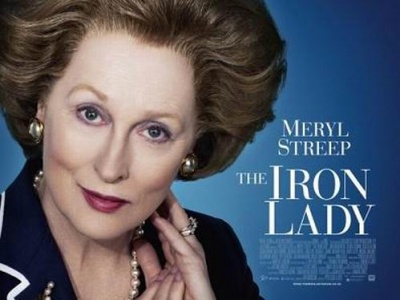
Former Prime Minister Margaret Thatcher escaped death in the Brighton bombing of 12 October 1984, as featured in the film The Iron Lady (for which Meryl Streep won an Oscar and BAFTA's Best Actress award in 2012).
The IRA bomb was planted in the Grand Hotel, Brighton, between 14 and 17 September 1984 and was triggered by a sophisticated long-delay timer.[5] Who supplied the IRA with the timer?
The film makes no mention of the biggest terrorist outrage in Britain: the sabotage of Pan Am Flight 103 over Lockerbie, Scotland, with the loss of 270 lives on 21 December 1988. The Lockerbie trial determined it was the Swiss firm MEBO that supplied Libya with the timer which detonated the Pan Am bomb just 38 minutes after take-off from Heathrow. There is a large body of opinion that disputes this finding, preferring instead to believe that the Lockerbie bomb was triggered by a barometric device.
Was it therefore a case of "if we can't get them for the Brighton bombing, let's frame them for the Lockerbie bombing"?[6]
Conspiracy by Reagan and Thatcher
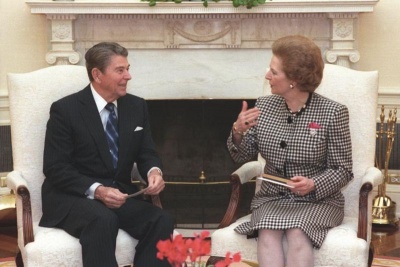
On 2 December 2010, in a video conference link to staff and students at the London School of Economics, Colonel Gaddafi alleged that the case against Abdelbaset Ali Mohmed Al Megrahi had 'been fabricated and created by' Britain's former Prime Minister Margaret Thatcher and former US President Ronald Reagan. He suggested that US CIA officials had been behind the 21 December 1988 Lockerbie bombing in which 270 people were killed.
"These are the people who created this conspiracy" said Gaddafi, referring to the alleged role of Thatcher and Reagan in Megrahi's conviction and life sentence over the attack on Pan Am Flight 103. "The charges directed towards Libya were based on unfounded evidence in an attempt to weaken the Libyan Revolution and limit its resources and abilities".[7]
In making his allegation, Gaddafi did not include ex-President (and former CIA Director) George H W Bush in this conspiracy. This may suggest that if Thatcher and Reagan had indeed 'fabricated and created' the Lockerbie bombing case against Libya, they would have done so in the interregnum between the 8 November 1988 US presidential election and President Bush taking over from Reagan on 20 January 1989.
Gaddafi's alleged Lockerbie conspiracy could well have been hatched on 15 November 1988 when President Reagan and Prime Minister Thatcher were photographed in the White House library and would undoubtedly have discussed Iran's threat to retaliate massively for the shooting down of Iran Air Flight 655 by USS Vincennes on 3 July 1988 with the loss of 290 civilian lives. The two leaders might then have decided to open secret negotiations with Iran and seek to limit the revenge attack to just one US aircraft. The US and UK would not have wanted to antagonise the Iranians further by blaming Iran for the retaliation, so would have selected 'mad dog' Gaddafi to be their whipping boy.
Western Intelligence Agencies (including apartheid South Africa's National Intelligence Service) would have been party to such negotiations and would have had a say in selecting the sacrificial aircraft. Thus on 22 December 1988 (the day after the Lockerbie bombing), President Reagan phoned Downing Street:[8]
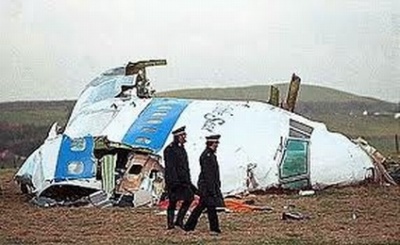
"Margaret, I understand you have just returned from the site of the Pan Am crash. I want to thank you for your expression of sorrow on the Pan Am 103 tragedy. On behalf of the American people, I also want to thank the rescue workers who responded so quickly and courageously. Our thoughts and prayers are with the victims of this accident, both the passengers on the plane and the villagers in Scotland".
On 28 December 1988, seven days after the Lockerbie bombing, when there was as yet no evidence ostensibly pointing to Libyan culpability, Ronald Reagan in one of the last acts of his Presidency, extended sanctions against Libya and threatened renewed bombing raids.[9]
Sure enough, the joint US/UK investigation into the bombing soon found 'evidence' pointing towards Libya for the sabotage of Pan Am Flight 103. According to author and journalist, Ian Ferguson, it was a case of 'reverse engineering' whereby Libya had been fitted up for the crime and the inculpatory evidence followed (see the 2009 documentary film Lockerbie Revisited).[10]
Lockerbie target
Of the 270 people murdered at Lockerbie on 21 December 1988, Assistant-Secretary-General of the United Nations and UN Commissioner for Namibia, Bernt Carlsson, was obviously a target. Yet the Lockerbie investigators (CIA, FBI and the Scottish Police) failed to undertake even the most cursory of investigations into Bernt Carlsson's murder.
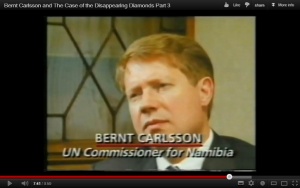
Commissioner Carlsson was to have taken charge of Namibia on 22 December 1988 immediately after apartheid South Africa had signed an agreement at UN headquarters giving up its illegal occupation of the country. In the months leading up to his death, Carlsson had warned that he would start proceedings against the countries and firms which had been defying UN law over many years by stealing billions of pounds-worth of Namibia's natural resources. Among those facing UN compensation claims were: the diamond mining firm De Beers; the apartheid regime of South Africa; Rio Tinto Group, owners of the Rössing uranium mine; and, the government of Iran which today still owns 15% of Rössing and, in 1988-89, received large shipments of uranium from Namibia. Because the UN Commissioner for Namibia was killed at Lockerbie, none of those prosecutions ever took place.[11]
The latest evidence suggests that apartheid South Africa targeted UN Commissioner for Namibia, Bernt Carlsson, on Pan Am Flight 103 and that Libya was not responsible for the Lockerbie bombing[12]
Thatcher "proud to be British"
Three months after the Lockerbie bombing, Margaret Thatcher and the rising star in Conservative Research Department, David Cameron, visited apartheid South Africa.[13]
The past and future British Prime Ministers made a point of visiting the Rössing Uranium Mine in Namibia (illegally occupied by apartheid South Africa in defiance of UN Security Council Resolution 435). In 1989, the Rössing mine was jointly owned by Rio Tinto Group and the Iranian Government, and was supplying uranium to develop Iran’s nuclear programme. Mrs Thatcher was so impressed with the Rössing Uranium Mine that she declared it made her "proud to be British", a sentiment echoed by David Cameron.[14]
It has recently been reported that Margaret Thatcher and David Cameron concluded a secret nuclear deal with the apartheid regime during their visit in 1989.[15]
Relationship to the Bilderberg Group
Denis Healey recalls that he invited Margaret Thatcher to the 1975 Bilderberg conference and that after listening in silence for two days:
"the next day she suddenly stood up and launched into a three-minute Thatcher special. I can't remember the topic, but you can imagine. The room was stunned. Here's something for your conspiracy theorists. As a result of that speech, David Rockefeller and Henry Kissinger and the other Americans fell in love with her. They brought her over to America, took her around in limousines, and introduced her to everyone."[16]
Bilderberg reporter Jim Tucker, attributes her downfall to a decision made at a meeting of the Bilderberg group, because she refused to allowed British sovereignty to be dismantled. When he asked her about it, he reports that she whispered back that she considered it a "great tribute to be denounced by Bilderberg".[17]
Tax loophole
In an article in 2002 on the subject of how 'Rich people are costing Britain millions in lost tax by not registering their houses in their own names', the Guardian[18] reports that Thatcher's home in Chester Square, London is registered as owned by Bakeland Property Ltd, Jersey. It was acquired in 1991 and Thatcher has it on 64 year lease. The shares for Bakeland Property Ltd are held by two Jersey individuals (Leonard Day and Hugh Thurston) who are the Thatcher family's financial advisers. According to the report, they are 'acting as nominees for a trust with concealed beneficiaries'. The former prime minister's office is reported to have refused to explain why she does not apparently own her own house. Leonard Day in Jersey is reported to have said: "No one's going to tell you about that." The article claims that through the exploitation of legal loopholes 'wealthy individuals... appear to be enjoying the country's choicest property virtually tax-free'. The article also mentions Anthony Tabatznik, Mohamed Al Fayed, David Potter, Tony Tabatznik, Lakshmi Mittal, Uri David, Rupert Allason, Wafic Said, Prince Bandar and Christopher Ondaatje as others who are not the registered owners of their homes who may benefit from such a loophole.
Thatcher's home is estimated to be worth at least £2.5m. As she is not the registered owner she has potentially avoided at least £100,000 in stamp duty and £900,000 in inheritance tax.[19]
Phillip Morris
In 1992 Margaret Thatcher signed on as an international consultant to the Philip Morris tobacco company at a pay rate of US $500,000 annually, with half to be paid directly to Mrs Thatcher and half to be paid to the Margaret Thatcher Foundation.[20] The Independent reported that Philip Morris paid for a 70th birthday bash for Mrs Thatcher on 23 October 1995 in Washington, D.C. with 800 guests attended and at an estimated cost of $1 million.[21]
Affiliations
- Centre for Policy Studies, co-founder
- APPG, vice president
See also
Notes
- ↑ "Ex-Prime Minister Baroness Thatcher dies, aged 87"
- ↑ "Thatcher mourned by few in South Africa"
- ↑ "Guess who is not coming to Margaret Thatcher's funeral"
- ↑ "From Chequers to Lockerbie"
- ↑ "Bomb expert links hotel device to Glasgow cache"
- ↑ "The Iron Lady's Revenge?"
- ↑ "Lockerbie bomber's family preparing to sue Britain for false imprisonment"
- ↑ "Reagan phone call to Thatcher at Downing Street"
- ↑ "Exploding Lockerbie – Part 2"
- ↑ "Lockerbie conspiracy by Thatcher and Reagan"
- ↑ "Bernt Carlsson and the Case of the Disappearing Diamonds"
- ↑ "Lockerbie: Ayatollah’s Vengeance Exacted by Botha’s Regime"
- ↑ "Cameron's freebie to apartheid South Africa"
- ↑ "Rössing Uranium Mine"
- ↑ "How the US and UK 'lost' three nuclear weapons"
- ↑ "Who pulls the strings?"
- ↑ Streeter, Michael. Behind closed doors: the power and influence of secret societies. p. 169.
- ↑ Evans, R & Hencke, D. (2002) 'Tax loopholes on homes benefit the rich and cost UK millions'. The Guardian 25th May 2002. Accessed 22nd May 2008
- ↑ Rob Evans and David Hencke, "Tax loopholes on homes benefit the rich and cost UK millions: Choice homes, virtually tax free", The Guardian, 25th May 2002
- ↑ http://legacy.library.ucsf.edu/tid/tnu34e00
- ↑ http://findarticles.com/p/articles/mi_qn4158/is_19951008/ai_n14010702
